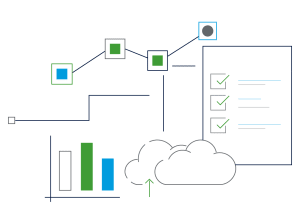What is stocktaking and how to prepare for it? Despite appearances, stocktaking is not only about the physical count of goods. The main purpose is to precisely determine the financial condition of the company. Stocktaking and inventory counting are activities which allow entities to determine the actual state of their assets and liabilities and compare it to the state shown in the records.
Obviously, the proper extent of stocktaking is only one of its requirements. Companies with this duty have to be aware of a number of other rules – for instance, the necessity to inform a statutory auditor of the time limit to record the inventory.
Below are frequently asked questions about stocktaking answered by our experts.
How to conduct stocktaking in a company?
Polish law provides for the methods of stocktaking, with the proper one depending on the type of assets and liabilities which will be covered by stocktaking.
Physical count is a type of stocktaking used for tangible current assets, property, plant and equipment, investment real estate, assets under construction, cash and cash equivalents (excluding bank accounts), and securities in physical form. To correctly perform stocktaking using this method, entities should use confirmations of balances which prove the existence of financial assets:
- held on bank accounts,
- held as paperless securities,
- present in the form of receivables, loans granted, and own assets consigned to contractors.
Assets and liabilities not listed above, such as land, disputed receivables, receivables from and payables to individuals who do not keep books of account or receivables and payables in respect of public levies, and items of property, plant and equipment to which access is considerably hampered are confirmed by comparing accounting data with relevant documents.
What are the time limits for stocktaking?
Polish law sets different time limits for different kinds of assets and liabilities. Companies are obliged to carry out stocktaking:
- on the last day of each fiscal year for:
- cash and cash equivalents – encompassing domestic legal tenders, foreign currency and foreign exchange, financial assets held on bank accounts, and financial assets kept by other undertakings,
- securities in physical form and paperless securities,
- work in progress, materials, goods and finished products whose value corresponds directly to their costs on the purchase date or at the moment of their production,
- items of property, plant and equipment to which access is considerably hampered,
- land or rights classified as real estate,
- disputed or doubtful receivables and receivables from and payables to individuals who do not keep books of account,
- receivables and payables in respect of public levies,
- other assets and liabilities in respect of which stocktaking by physical count or reconciliation was not possible for justifiable reasons (e.g. goods in transit, intangible assets, investments classified as financial fixed assets, equities, provisions, impairment losses, or special funds),
- within the last 3 months of a fiscal year, on or before the 15th day of the following fiscal year for:
- tangible current assets located in an unguarded area or located in a guarded area but not covered by the register of quantities and values,
- items of property, plant and equipment located in an unguarded area,
- items of plant and machinery located at an unguarded area constituting assets under construction on the balance sheet date,
- assets owned by other undertakings which have been consigned to the entity for sale, storage, processing, or use,
- receivables – including loans granted (excluding those for which stocktaking is carried out by verification),
- own assets consigned to contractors,
- once a year for:
- stocks of goods and materials (packaging) covered by a value-based register in an undertaking's retail outlets,
- stocks of wood in undertakings carrying out forestry activities,
- once every two years for:
- stocks of materials, goods, finished products, and semi-finished products located at guarded storage sites and covered by a register of quantities and values,
- once every four years for:
- real estate classified as property, plant and equipment and investments, and also other items of property, plant and equipment located in a guarded area and items of plant and machinery constituting assets under construction.
Learn more about our services
What is continuous stocktaking?
Continuous stocktaking is a procedure whereby the actual stock level of an undertaking is determined on a step-by-step basis by spreading stocktaking activities throughout a period of two years. Continuous stocktaking may be only applied to stocks kept at guarded storage sites and covered by an accounting register of quantities and values.
Entities using this method of stocktaking have the possibility to conduct physical count on a day of their choice (or on a step-by-step basis) in a period of two years. It is worth noting that within the period specified in the Accounting Act, all components of a given asset covered by continuous stocktaking of an undertaking must be counted.
It is important to carefully plan all stages of continuous stocktaking. In the first place, the entity should prepare a schedule setting out the dates and extent of stocktaking for individual stock components.
In accordance with the Accounting Act and pursuant to Point 79 of the Comments of the Polish Accounting Standards Committee on Stocktaking, entities may count stocks covered by an accounting register of quantities and values and kept at guarded storage sites at any time, provided that such stocktaking is performed at least once every two years.
In the same Comments, the Polish Accounting Standards Committee listed additional conditions which the entity must meet in order to be able to use the method of continuous stocktaking by physical count: the stocks must be kept at guarded storage sites and covered by a register of quantities and values, the register of quantities and values must be maintained in a way that allows the entity to accurately determine any potential stocktake discrepancies for every day of the count, the entity must have in place an internal policy regulating in detail the procedure of continuous stocktaking, and the storage site must be divided into count areas making it possible to perform stocktaking activities during one day. Furthermore, the information concerning stocks in these areas must be updated on a regular basis.
To use the method of continuous stocktaking, it is necessary to have confidential stocktaking schedules which are continuously updated. Physical counts should be carried out in a timely and accurate manner, in line with the prepared schedule.
What documents must be prepared for each stage of stocktaking by physical count?
Before proceeding with stocktaking, the manager must issue an official order on this operation.
The content of the order depends on whether there is a standing stocktaking committee in place or whether such a committee is established for the purpose of performing a particular task. In the latter scenario, the order names the members of the stocktaking committee, including its chairperson, the kinds of stocks covered by the count, the scheduled date of the count (i.e. the date of determining the actual level), and the start and end dates of the stocktake (settlement).
In accordance with the order, the persons in charge of particular stocks are obliged to be present during stocktaking.
A site plan is a map of the entity's area which clearly indicates the storage sites of different kinds of stocks of the entity.
A site plan includes the names of the storage sites, names the persons in charge of particular kinds of stocks, and defines the product mixes of the stocks stored in these specific areas. An up-to-date site plan facilitates identification of count areas, in particular in entities with a diverse product mix of stocks and several storage locations. This in turn makes it possible to appropriately select members of the count team and determine the proper size of the count area, so that it is plausible to perform physical count during one day.
As far as a physical count schedule is concerned, it includes count areas, dates of performing physical counts in these areas, and designation of count teams responsible for stocktaking in particular areas. A count team may conduct stocktaking in one or more areas.
A physical count schedule typically covers one stocktaking cycle, i.e. an annual or multiannual cycle.
Stocktaking instructions aim to facilitate the organisation and process of stocktaking as well as the selection of appropriate procedures adjusted to specific conditions. They can take the form of a single (general) instruction or several smaller ones, each dedicated to particular groups of persons or kinds of stocks.
Set 1 – Instruction for the members of the stocktaking committee:
It defines the rules of operation of the stocktaking committee and the process of appointing count teams and, if applicable, inventory controllers.
It sets out the scopes of responsibility of individual members of the committee, division into count areas, and adopted simplifications or special procedures for stocktaking by physical count.
It focuses on the description of stocktaking records, the rules governing accounting for stocktake discrepancies, and the manner of keeping documents.
Set 2 – Instruction for count teams:
It often includes specific instructions regarding stocktaking activities for particular kinds of stocks.
This instruction defines the method of identification, measurement, and recording of certain materials (e.g. angle bars, rods, sheet metal) during stocktaking.
It can also contain specific guidelines regarding the nature of taking inventory of certain kinds of stocks, such as pipes, coal, scrap, or other bulk materials.
Acting as a supplementary tool in the organisation of stocktaking, it aims to ensure the integrity of activities, minimise the risk of errors, and facilitate effective cooperation among different teams involved in the stocktaking process.
Stocktaking and physical count: What should the inventory record look like?
In inventory records, stock takers include measurement results (also estimated) taken during the physical count. Inventory records should contain at least the following elements:
- Heading – containing the name of the entity, record number, designation of the count area and object of stocktaking, date and duration of stocktaking, and members of the count team.
- Table with spaces for counted items – which contains: item number, designation of the product mix, units of measurement, and, if necessary, units of measurement used in the accounting register of quantities.
- Completion – by entering the following sentence in Polish below the last recorded item: „Spis zakończono na pozycji....” (The count was completed at item...) and providing the number of the item or by striking through all empty spaces below the last item. Also necessary are signatures of all the members of the count team, signature of the person in charge of the property or his or her deputy, and comments of this person, if any. If the person in charge does not participate in the count, a relevant note is made in the record.
Each form must be filled in legibly and blank spaces should be avoided. However, if there are some blank spaces or endings left, it is recommended to strike them through to prevent adding any additional remarks after the count.
Except for records of third-party stocks, it is advisable to create forms in one sheet, without copying. Taking notes which would provide the basis for completing the forms at a later date is not recommended.
Inventory documents should be prepared in a manner to prevent any altering of records.
Small mistakes and errors can be corrected by striking through the wrong entry with retaining its legibility, making the correct entry, and marking the correction with a signature and date. In other cases, the wrong entry is struck through, and the correct one is entered in a separate item of the inventory record. Members of the count team sign under the struck entry and indicate the space of the correct entry.
The completed inventory records are signed off by all members of the count team and the person in charge of the items covered by the stocktaking, which means that this person has no objections to the recorded entries. The chairperson of the committee checks if the number of issued and returned inventory record sheets is the same and verifies the completeness and accuracy of stocktaking evidence (inventory records).
How to prepare a stocktake discrepancy report?
After finding the cause of discrepancies, the stocktaking committee draws up a stocktake discrepancy report containing justified proposals of the committee concerning the manner of accounting for each stocktake discrepancy. This document is then submitted to the manager of the entity.
The report is accompanied by a breakdown of stocktake discrepancies or a collective breakdown. The manager of the entity then approves the committee's proposals, implementing any changes beforehand, after hearing an accountant's opinion and, where necessary, consulting a legal advisor.
On the basis of such a discrepancy report, approved by the manager of the entity, the accountant adjusts the discrepancies in the books of account accordingly, recording everything as at the date of the count – not later than the last day of the fiscal year covered for which the physical count is performed.
If the committee finds during checking procedure any of the discrepancies occurred as a result of a criminal offence (such us theft or forgery), the chairperson of the stocktaking committee submits a written proposal to the manager of the entity to report this fact to law enforcement authorities.








